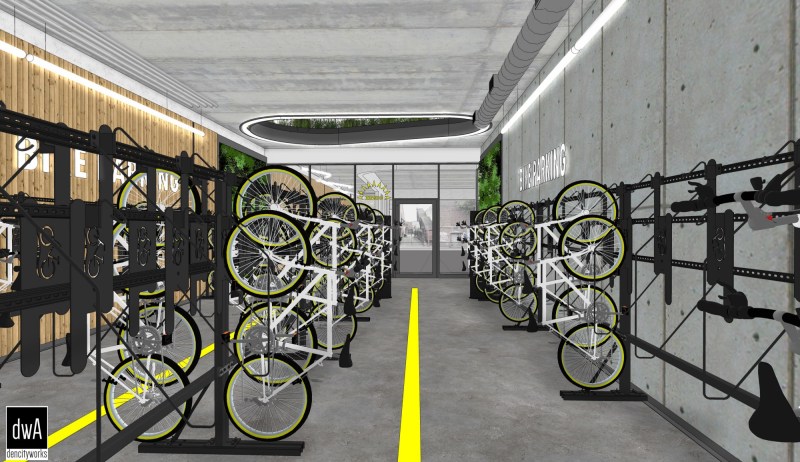Oonee and ULURP — Perfect Together?

It looks like the only way New York City is going to get secure and free public bike parking is if communities, council members or city planners demand such amenities when they grant lucrative rezonings to private developers.
In a little-noticed footnote to a rezoning proposal approved unanimously last week by a Brooklyn community board, a development firm called Totem promised to include a free bike-parking station with more than 100 spaces for the public at its new building on Atlantic Avenue near the Franklin Avenue C and shuttle stations.

It’s the second time Totem has won a zoning change after promising public bike parking built into the plan (among other community amenities including a high percentage of below-market-rate units).
“If you’re coming to the neighborhood seeking a zoning change, ideally, you want to include amenities — and private developers should do whatever they can to encourage biking,” said Tucker Reed, the Totem principal. “Bike parking is one of those amenities because it’s so important. I’ve had several bikes stolen. And if this is your way of getting around, having your bike stolen is a big deal.”
Reed also added bike parking to his development in Sunset Park, which was approved in March. In that building, Council Member Carlos Menchaca advocated for dedicated bike parking for delivery workers, in addition to other members of the public.
New York has long failed at creating large, European-style secure bike parking at major destinations or near transit. Indeed, the builders of the new $1.6-billion Moynihan Train Hall (looking at you, Gov. Cuomo) missed a big opportunity to seamlessly include bike parking (the kind you see at stations in Holland). And the city failed to make such a demand when it approved a rezoning to create a 1,415-story tower next to Grand Central a few years ago (point of information — there aren’t even benches on that plaza!). Yes, developer SL Green did offer $200 million in improvements, but creating hundreds of secure bike parking spaces would have added less than a million to the development firm’s costs. The problem: None of the players in the city’s Uniform Land-Use Review Procedure asked for it. And there are scores of rezoning applications every year.
“The cost of these things is tiny — like a rounding error,” said Shabazz Stuart, the founder of Oonee, which is creating the bike-parking rooms in both of the Totem buildings. “It’s literally nothing. I use two four-letter words in all my discussions with the city: ‘free’ and ‘easy.’ We can create free bike parking — you just have to demand it in the ULURP. This is a model that the city should adopt across the board.”
Every one of these rezoning applications “could incorporate public secure bike parking facilities at the direction of advocates, communities and elected officials,” Stuart added.

Reed said that he hopes developers will see the benefits of including secure bike parking as part of their neighborhood amenities package, but such things take time in a moribund culture.
“It’s an awareness thing,” he said. “The development process has so many risks — political, financial, construction — so most developers follow a cookie-cutter approach until consumers demand things. As more and more people bike, more and more community boards and council members can demand that buildings themselves become more bike friendly.”
Certainly someone has to do something in the absence of city action. It may not sound so crucial in a city where cyclists have become accustomed to locking their bikes to the nearest parking sign, but the lack of secure bike parking remains a huge impediment for many riders. A Transportation Alternatives said the parking shortage — London has 7,500 secure bike spots while New York has, basically, none — is the second most-common reason that people choose not to bike.
The lack of bike parking also hurts local businesses, the group showed.
Obviously, using the ULURP process to get bike parking isn’t the only way to achieve this important policy goal, but it can clearly help achieve the goal in new buildings. Stuart is still working on several ways to bring free bike parking to New York, including responding if the city gets around to seeking proposals for curbside installations and larger bus shelter like installations. Those facilities would be part of the same network as the public bike stations in private buildings, Stuart said.





